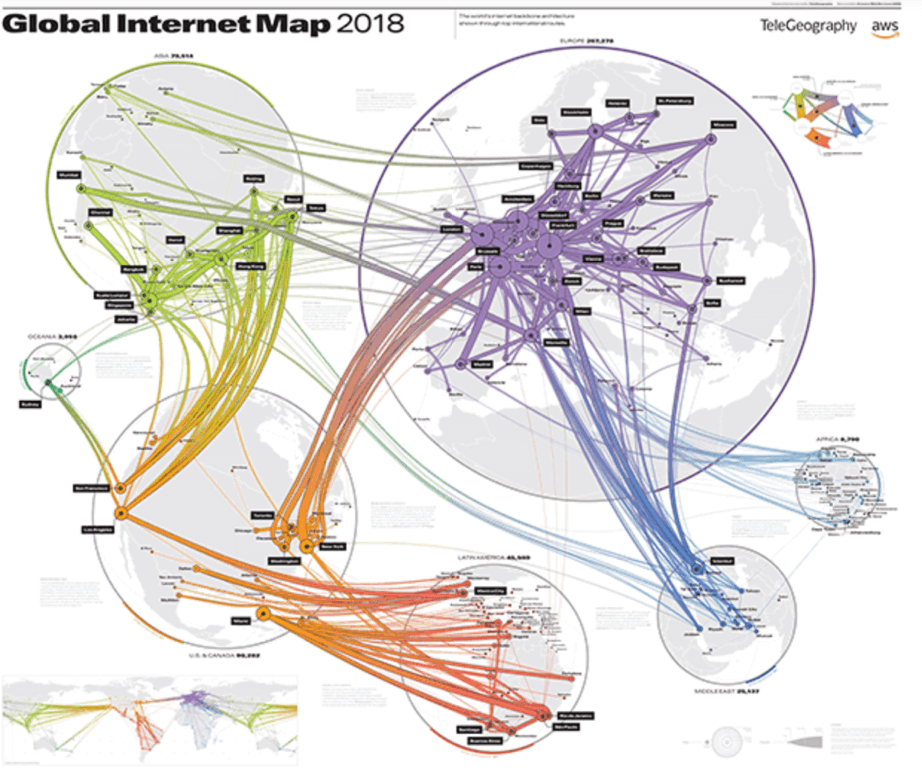
We rarely notice the underlying structures that make up our application experiences.
Have you noticed that sometimes knowledge of IT networking fundamentals can be quite low among technical people who have a software focus? There is a presumption that the network is always there, almost like magic.
However, IT networking is a complex space with a lot of mature technologies and many preconceived notions about how networks should operate. For a beginner, getting a handle on IT networking fundamentals is worth the investment.
The Internet is a Network of Networks
The internet, for example, is one giant network of networks. It’s not a thing or a place. It is a network of cables that crosses oceans, connecting data centers to computers, tablets and smartphones around the world.

Source: News Scientist
Despite the sheer magnitude of the internet, most people — consumers especially — don’t think about these networks or even know they exist. Websites, applications and data just magically appears at the click of a button on a laptop, tablet or phone.

Source: Global Internet Map 2018
Perhaps one of the reasons networks are “invisible” is the seamless user experience delivered by WIFI, LTE, 4G and soon 5G technology. By removing the need for old-school ethernet cables that once tied computers to desks, we’re free from thinking about physical connections. When information is sent over the air and magically appears, we begin to take it for granted, as if it was always there and is a simple, low-cost thing to deliver.
Today, the average American spends 5.4 hours per day on their phones. Smartphones are now capable of high computing power where things “just happen” and data is always there — regardless of whether or not the user is at home. The science behind this modern technology is not always understood. In fact, it’s barely even appreciated.
The Importance of IT Networking in Application Development
Even platforms as new as Kubernetes have had to change to increase their support for networking. Kubernetes is a portable, extensible, open-source platform for managing containerized workloads and services. It was built to run distributed systems over a cluster of machines. The very nature of distributed systems makes networking a necessary component of any Kubernetes deployment. But at its initial design and manifestation, fundamental networking capabilities were not included in Kubernetes and have later been added.
Understanding IT Networking Fundamentals
In simple terms, IT networks allow computers to connect and communicate with different computers via any medium.
There are several major types of IT networks: LAN (Local Area Network), MAN (Metropolitan Area Network), and WAN (Wide Area Network). The major difference between them is the geographical area they cover. For our purposes, the type of network we’re going to focus on is the Wide Area Network.

IT Networking Fundamentals: An Introduction to SD-WAN
Software-Defined Wide Area Network (SD-WAN) delivers all the business benefits associated with software-defined networking (SDN) but in the context of a wide area network (WAN). Simply put, SD-WAN transforms WANs from static, hardware-centric networks to agile, software-defined virtual services that operate over top of and independent of the physical networks underneath them.
To do this, SD-WAN separates the underlying networking hardware from its control mechanism. This makes it possible to establish simple yet powerful virtual networks that can be easily managed and controlled from a centralized location. In essence, SD-WAN automates network deployment and management, virtualizing resources to supply enhanced performance, accelerated services delivery, and improved availability.
An SD-WAN network is based on establishing tunnels between sites that operate as an abstraction layer over top of the physical networks:
- Each site has a device running SD-WAN software that is the interface between the LAN and the SD-WAN network.
- The SD-WAN works by measuring essential network traffic metrics (latency, packet loss, jitter, and availability).
- It responds to real-time network conditions, selecting the best path for each data packet.
- Many SD-WAN include features such as acceleration, encryption, and quality of service (to prioritize specific packets such as voice or video calls in order to deliver the expected level of quality for end-users).
Should one last-mile connection stall, the SD-WAN device automatically fails over to the alternative connection, using pre-configured policies to manage the traffic load.
SD-WAN adoption is growing rapidly because the technology provides a wide range of important operational and financial benefits for end customers and MSPs.
Turnium Makes Networking Easy for MSPs
Many SD-WAN platforms lack the true customization ability that MSPs require. As a result, service providers find themselves locked into using the vendor’s hardware, data centers, and network infrastructure. This means surrendering control of the service delivery to a third party.
With Turnium, service providers own the network and the network performance so they can ensure optimal performance for the services they provide to customers. Further, Turnium OEMs its SD-WAN software so service providers can integrate the SD-WAN into their products, service delivery, and operational delivery while taking advantage of Turnium’s unique business model. Instead of reselling a vendor’s SD-WAN service, by licensing Turnium SD-WAN, service providers can bring their own SD-WAN service to market quickly and easily, while retaining full control over the offering, packaging, pricing and delivery.
